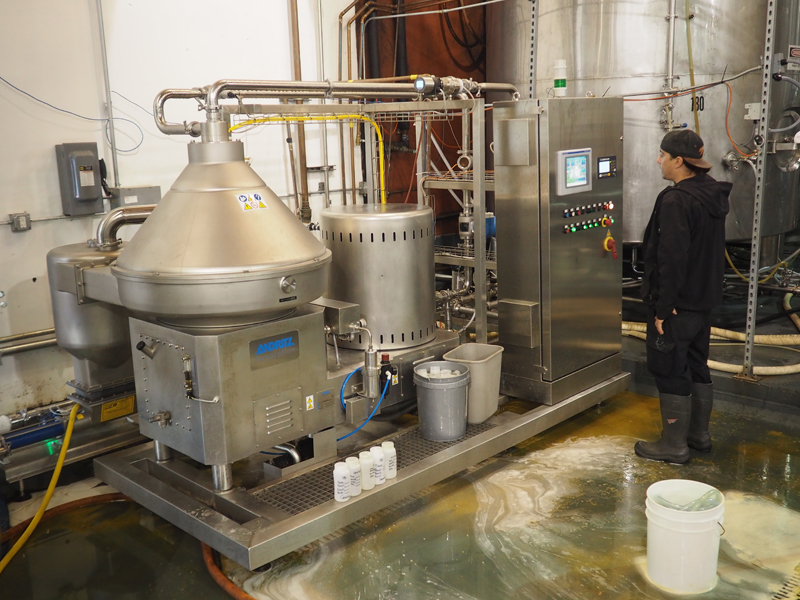Little Spinners: Centrifuge Technology Enters Small Brewing Niche
Editor’s Note: This story appears in the July 2016 issue of All About Beer Magazine. Shortly after the video was produced, Kushal Hall vacated his position at Speakeasy to return to Southern California.
We like to refer to sweeping behind-the-scenes changes as quiet revolutions, but one such change that’s taking place in smaller breweries is anything but quiet. That’s the arrival of centrifuge technology.
“When it ejects solids in a run, it’s really loud. It’s offensively loud,” says Robbie O’Cain, brewmaster at Starr Hill Brewery in Crozet, Virginia. The brewery recently installed a GEA-brand centrifuge, joining a growing number of brewers moving away from filters.
So what, you might ask, does that mean for you? Fair question. How about this? Greater hops oil retention.
“We wanted to be able to separate the high concentrations of hop oil in these high-solids beers,” O’Cain says. “The top 6 inches [of solids] in the [fermentation] tank has this enormous concentration of hops oils, [but also] a lot of hop material, so it used to go down the drain. Now you get to keep that. That’s one of [the] big components in driving IPA character. In nearly every instance we’ve run, it’s been to the gain of the beer.”
Brian Stechschulte, at Speakeasy Ales & Lagers in San Francisco, agrees about the hop oil, noting that the beer’s actually a bit hazy with it now. But that’s not all they’re getting from the new Andritz centrifuge. “Better shelf life, because zero oxygen gets in during clarification now,” he adds, “and we notice significant differences in certain beers. It’s hard to describe: the flavors aren’t … muddled. Our Tallulah Extra Pale Ale just sung; you could pick out the flavors much better. It pulls out the aromas and flavors you want and puts them right there.”

The centrifuge at Speakeasy Ales & Lagers in San Francisco (Photo by Jon Page)
Centrifuges, or separators, have long been used at large, modern breweries. Freshly fermented beer enters the centrifuge, where it meets a number of rapidly spinning (around 5,000 rpm or more) plates. Solids (hop debris, brewing proteins, yeast) spin out to the edges and are ejected; beer stays in the middle and is carried away, and all of it happens without exposure to oxygen.
The devices have a number of advantages over traditional filtering. Filters use a series of plates (most often a sort of cellulose sponge) holding filtering medium, usually a coating or thin bed of diatomaceous earth (DE). The beer passes through, leaving the solids behind. DE is a crushed fossil-bearing rock that makes an excellent filter, but it has disadvantages as well.
“It’s a tremendous filter,” O’Cain says. “Lots of little holes, and they’re positively charged [which attracts tiny particles]. But we used about 25 kilos of DE per run, and it’s not really reusable. It’s not the most fun to deal with, a really fine powder, almost as fine as flour. It puffs up and gets anywhere.” DE filters also have trouble handling the heavy loads of sediment from the newer hop-heavy beer styles, and they can’t filter the cone of sediment at the bottom of conical fermenter tanks, which means not just hop oil is lost: Gallons of beer are wasted. Filters are also slow, and brewers have to allow tanks to settle before they can filter.
Still, small brewers didn’t have any other real options; centrifuge technology was too big, and too expensive. That’s changed. Look at the ProBrewer online forum about beer clarification as recently as five years ago and everyone’s talking about filters; by 2014 it’s all centrifuges. John Berardino, the brewery sales manager U.S. for Swedish centrifuge manufacturer Alfa Laval, notes how quickly things changed.
“There were separators in craft breweries before 2010,” he says, “but under 5,000 barrels per year production, they weren’t really there. Then we started to see requests from those smaller brewers.” He believes that there are two important factors. First, the overall beer quality has improved to the point where having a centrifuge makes sense; the easier fixes have all been done, and this is the next step. Second, he acknowledges that while centrifuges are expensive, bankers and investors have recognized that local brewing is a solid business, and centrifuges have an immediate effect on efficiencies and costs.
“You’re getting more beer out of every tank than with a filter,” O’Cain explains. “You can run it slow and filter barrels of beer you’d otherwise run down the drain. You decrease batch time; you don’t have to wait for the yeast to completely settle. We’ve seen a 7-12 percent increase in yield, and you’re lowering your cost of goods sold by increasing your yield. Those aren’t the glorious things, but it’s a real benefit to us. More so than many industries, craft brewers have celebrated the glories of inefficiencies. But if we can do things to reduce costs and maintain quality, we’re going to do that.”

Centrifuge samples at Speakeasy Ales & Lagers (Photos by Jon Page)
Some brewers are concerned that if fans hear “reduce costs,” they’ll assume “lower quality.” But Stechschulte says people get it. “We try to educate people on the tours on what it does and how it works,” he explains. “ ‘Better shelf life’ and ‘hoppier’ are eye-openers. We’ve been really honest with them [about the cost savings], and they like it. They appreciate it.”
Still, says Berardino, the need for a filter isn’t gone. “A separator is not a magic box. It does not stabilize beer haze. If you’re making a bright pils, you’ll probably want to do something other than just run it through the separator.” For instance: a DE filter to polish the beer. Making a really great glass of beer definitely takes a team effort; that hasn’t changed.–Lew Bryson

beer indiana